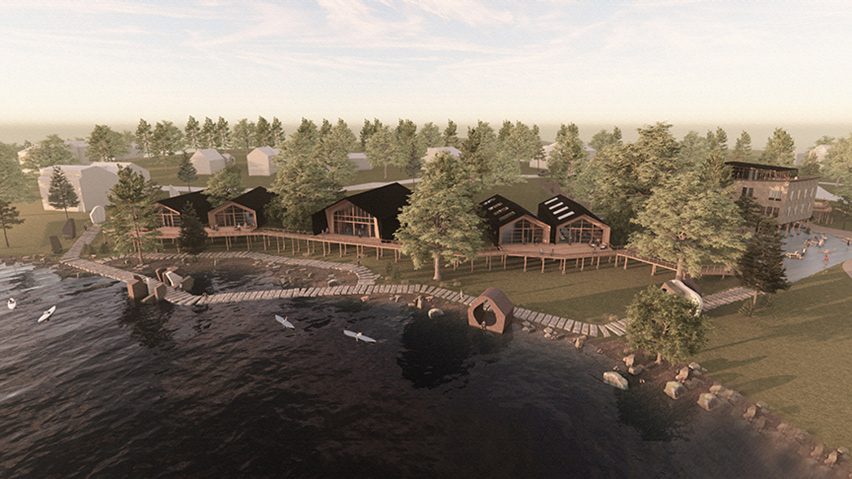
Drexel University spotlights 15 architecture and design projects
Dezeen School Shows: a community-focused hospice that aims to improve people's end of care experiences is included in Dezeen's latest school show by students at Drexel University.
Also included is research into empowering cryptocurrency investors, how persuasive social media technology affects students, and how trauma care can be improved.
Drexel University
Institution: Drexel University
School: Department of Architecture, Design and Urbanism
Courses: B Architecture, BS Interior Design, MS Interior Architecture and MS Design Research
Tutors: William Mangold, Dee Nicholas, Jackie Niemiec, Frances Temple-West, Eli Robbins, Rachel Schade, Sarah Lippmann, Sequoyah Hunter-Cuyjet, Jihyun Song, Karen Pelzer, Nicole Koltick, Diana Nicholas, Don Jones, Kelly Vresilovic and Jeff Krieger
School statement:
"Drexel University offers the nation's top programmes for experiential learning with dedicated co-op work experiences and a mission of civic engagement.
"The Department of Architecture, Design and Urbanism includes undergraduate programmes in Architecture and Interior Design, and graduate programmes in Interior Architecture, Design Research and Urban Strategy.
"Work from our programmes explores qualities of place and considers that our lives are constantly shaped by the spaces we inhabit.
"At all scales we respond to the form, light and materials of the world around us, and we actively engage our social and natural environments. Through research and design interventions, our work enhances our lives and promotes community."
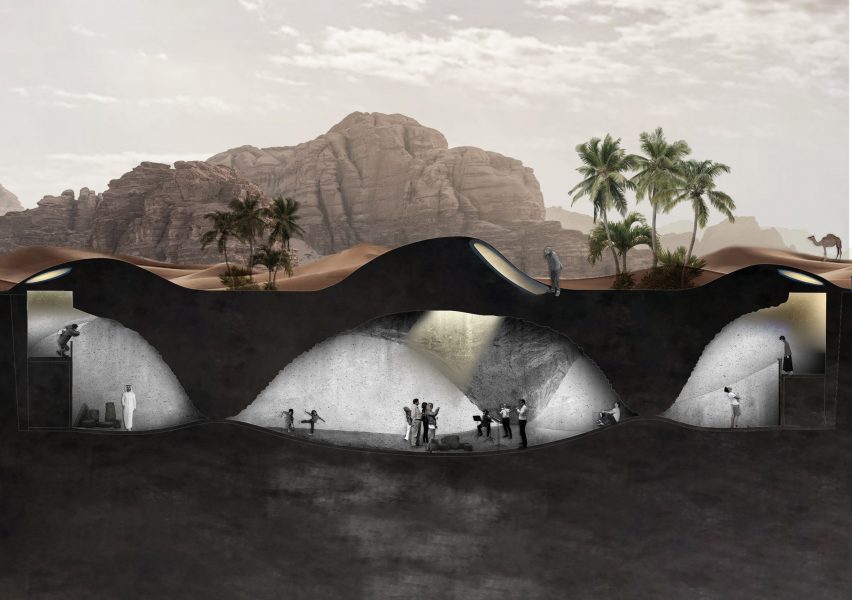
Installation Art and Live Performance as a Means of Exploring Place History by Afnan Bashaikh
"Historic places are visual narratives with natural scenic appeal. Art plays an integral role in highlighting such places that define cultural and social values.
"This applies to installation art that emerged from integrating the notions of space-making and storytelling to spark curiosity, intrigue and public engagement.
"My thesis project focuses on methods of developing an immersive experience where inhabitants are compelled to lose their sense of self and become utterly involved with a constructed cosmology of visual stories.
"The site selected for the project is the historic city of Al-'Ula in Saudi Arabia known for its complex tapestry of archaeological formation and offers a great potential of hosting an inhabitable art installation.
"By allowing a subtle invasion of the place's history through a modern lens, I believe that a strong sense of place can emerge and a form of the imagination will meet reality."
Student: Afnan Bashaikh
Course: MS Interior Architecture
Tutor: Eli Robbins
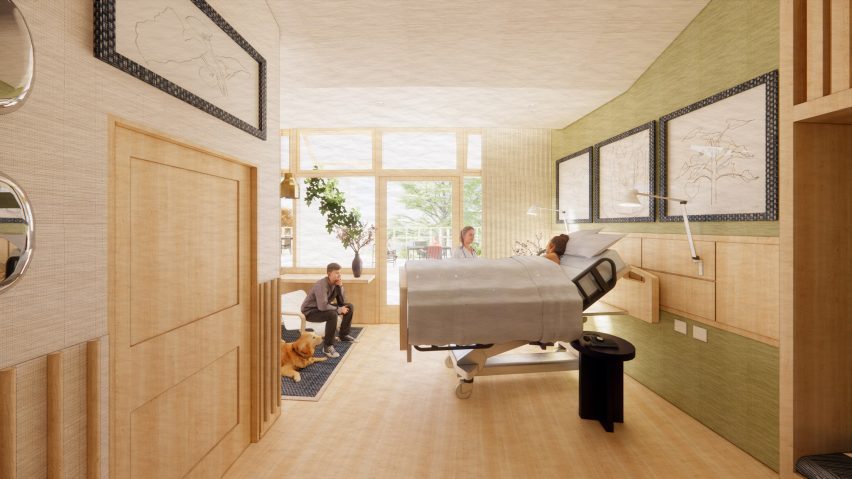
A Home at the End of Life: Designing for Hospice Care by Bridget Maguire
"Modern hospice care design is currently made up of four building typologies, including a wing within a hospital, a building connected to a hospital, an independent facility and at home care.
"These current typology designs are deficient in the care of both their patients and their patients' families and caregivers. There is a current culture of silence around death that can be read in these typologies and instead of making people feel at home, they produce undue stress, anxiety and isolation.
"My thesis project challenges the current hospice care building environments by using architecture and design to improve end of life care experiences.
"My design will seek to enable and allow patients to live their life to the fullest through the engagement of the senses, creating a sense of home and community, and creating spaces that metaphorically and physically assist and guide patients and their families through this final journey."
Student: Bridget Maguire
Course: MS Interior Architecture
Tutor: Rachel Schade
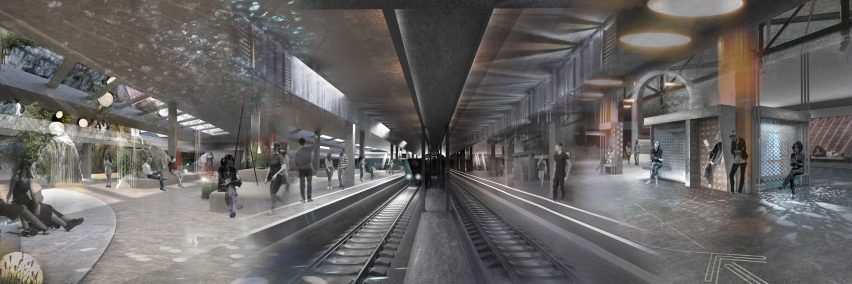
Space Memory: The History of Waiting by Olia Voronezhskaia
"Underground Transit Station — a liminal space that makes waiting an event. A place of repeated and layered transitions experienced actively or passively, giving unique opportunities to observe physical and social space in the present time, at a present scale and with present people.
"These daily transitions become an elevated journey through spatial perceptions and interpersonal dynamics.
"Urban Frame Station is a space that lives in the future and has memories, experiencing direct interactions with time through the senses. How does this station remember us waiting?"
Student: Olia Voronezhskaia
Course: MS Interior Architecture
Tutor: Sarah Lippmann
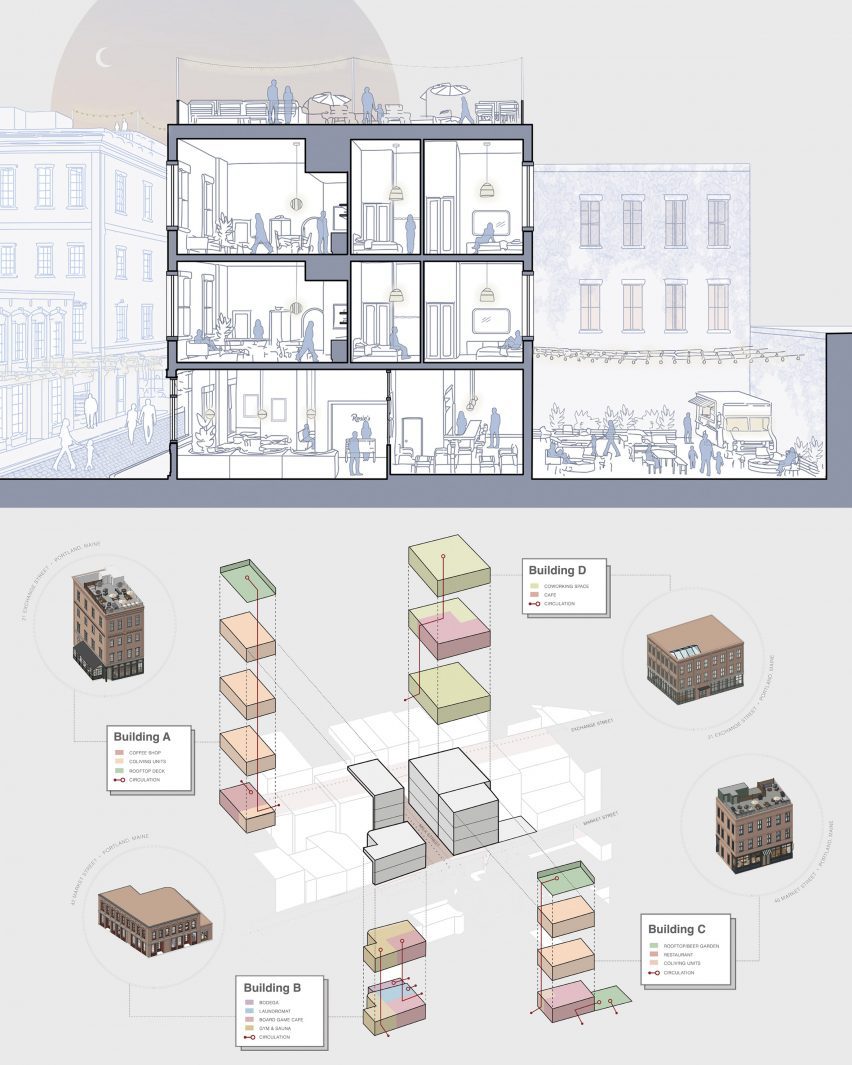
Unprecedented Times: The Future of How We Work by Lisa Singer
"The Covid-19 pandemic created an unexpected and unprecedented global work experiment that permanently changed how we work, where we work and the role work plays in our lives.
"This abrupt transition from a 'traditional' on-site work model to a remote work model has had a prolonged effect on people on psychological, emotional and professional levels. While productivity levels increased, wellbeing and work/life balance decreased.
"I saw this as an opportunity to reimagine the hybrid work model in a post-pandemic world. How do we combine the best parts of working on-site, such as socialisation, movement and routine, with the flexibility of working remotely?
"This thesis proposes a co-living and co-working community where groups of friends or colleagues can stay for extended periods of time to work remotely all while exploring the city of Portland, Maine together.
"Through deliberate space planning of the site, I decentralise 'work' and 'life' functions to foster socialisation and movement and increase well-being and work/life balance."
Student: Lisa Singer
Course: MS Interior Architecture
Tutor: Sequoyah Hunter-Cuyjet
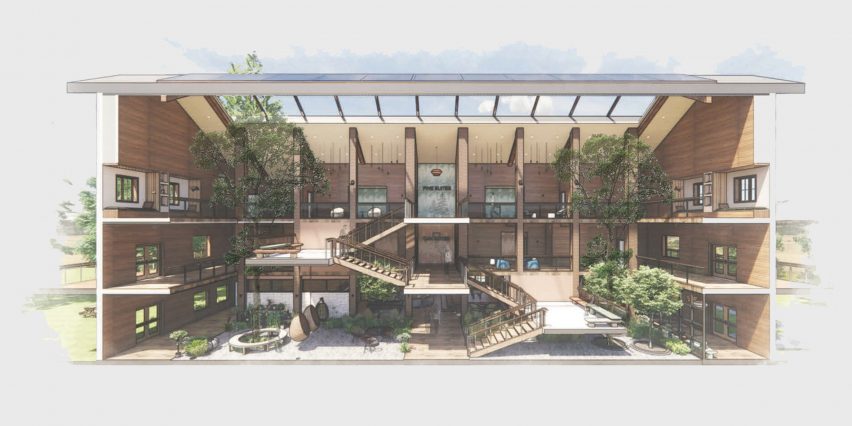
Evergreen Youth Retreat by Sophie Rupert
"Evergreen provides an escape for young people from busy concrete cities, to reconnect with the environment and the world around them.
"Located near Lake Tahoe, Evergreen creates an immersive experience for people to strengthen their relationship with natural environments, from interior to exterior.
"This seasonal retreat encourages young adolescents to explore their passions, learn and create new relationships."
Student: Sophie Rupert
Course: BS Interior Design
Tutor: Frances Temple-West

Modular Multigenerational Homes by Lidya Ang
"This is a multigenerational home that grows and adapts to changing family dynamics.
"It allows many generations of a family to coexist with one another while still providing a sense of privacy.
"It is set in an urban environment and addresses the challenge of limited space."
Student: Lidya Ang
Course: BS Interior Design
Tutor: Jihyun Song
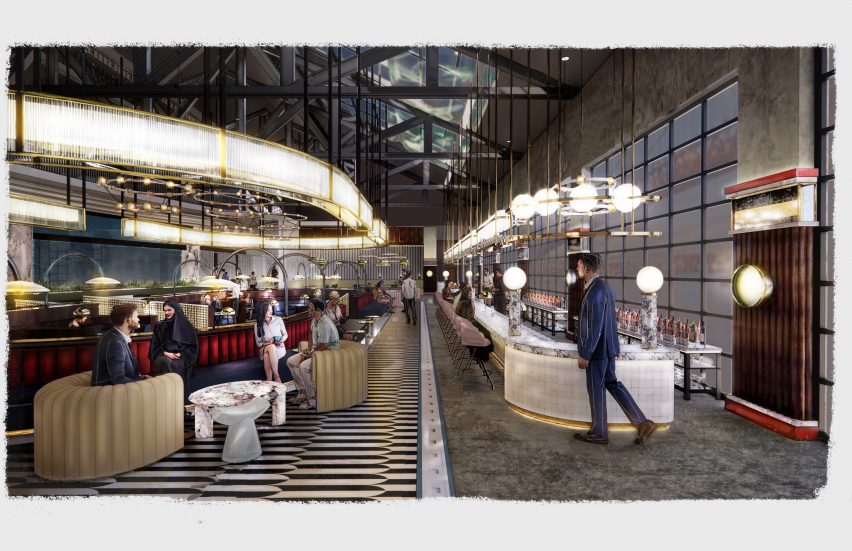
Rove: Exploration of Sporadic Hospitality by Michael Quaglia
"Rove utilises a pre-existing industrial shell and interweaves hospitality and the sense of exploration throughout.
"The winding path alludes to venture and the aspiration of continuing forward to experience spectacles of design, form and society.
"Rove develops modular units that are placed on the second floor to ensure the exploration of the inhabitant.
"Visitors and inhabitants explore amenities throughout the building as well as sensory qualities of water that connect to the surroundings as a fluid threshold between the built environment and the nomadic sense of self."
Student: Michael Quaglia
Course: BS Interior Design
Tutor: Karen Pelzer
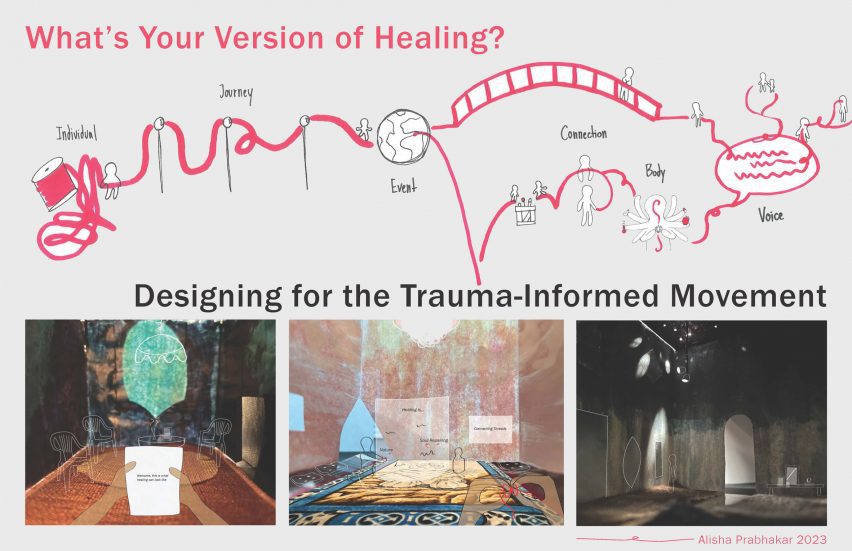
What's Your Version of Healing? Designing for the Trauma-Informed Movement by Alisha Prabhakar
"Trauma is like light: it is energy that can be felt but not seen. Stemming from experiences as early as childhood, it can manifest into unhealthy behaviours and patterns, which are often passed down to the next generation unintentionally.
"In our current, post-2020 world there's a global desire to heal, but what does 'healing' mean? How does someone define their safe spaces?
"Research and design are combined in novel ways to create trauma-informed resources for minority and immigrant communities on multiple scales, such as an experiential exhibit that brings transparency to mental health services like therapy sessions.
"The research also analyses how trauma-informed care, design and public policy can be better aligned to mitigate the effects of intergenerational trauma.
"This project follows threads from different life experiences in an effort to weave together ways to heal from trauma.
"The research publication also serves as an accessible guide to understanding healing and for professionals implementing trauma-informed practices to expand the boundaries of the industry."
Student: Alisha Prabhakar
Course: MS Design Research
Tutors: Nicole Koltick and Diana Nicholas
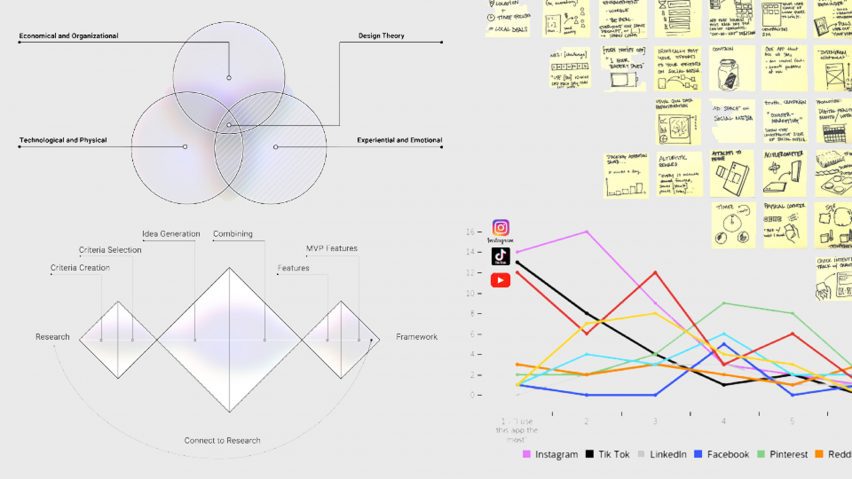
Social Media and the Undergraduate Experience: Recommendations and Multi-Method Design Research in Attention and Productivity by Michael Olk
"Considering how social media companies compete for the attention and engagement of their users, this project focuses on how persuasive technology within social media negatively contributes to undergraduate students' wellbeing and academic performance.
"Through multi-method design research, this project uncovers the economic landscape in which this problem exists, analyses TikTok as a leading example of persuasive tactics within social media, and maps undergraduates' experiences and relationships with social media.
"The outcome was a set of initial recommendations for designers and researchers developing solutions for young adults who want to regulate their social media use.
"A framework was also produced that suggests a direction for an app solution. This direction allows users to discover ways social media is made to be addictive, create tools to mitigate the downsides of social media, and connect users to the broader selection of tools made by other users."
Student: Michael Olk
Course: MS Design Research
Tutor: Diana Nicholas
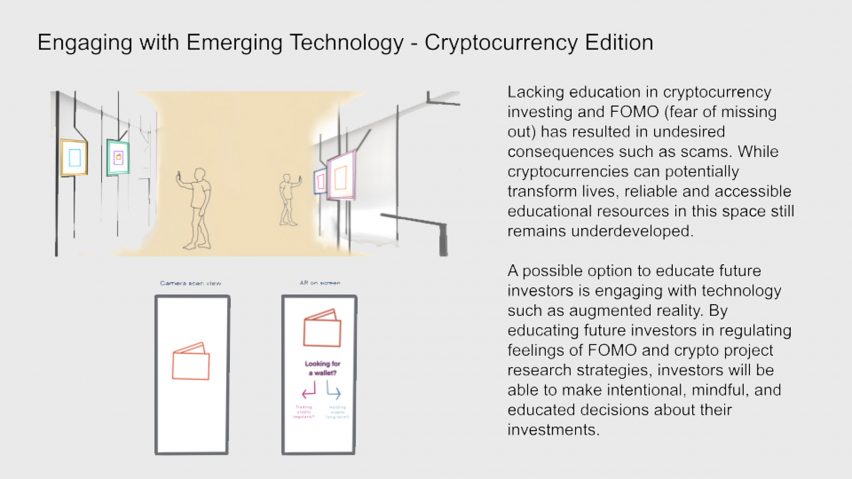
Engaging with Emerging Technology: Cryptocurrency Edition by Vanessa Xie
"This research is driven by the observation of cryptocurrency popularity cycles and the prevalence of scams in the industry.
"The aim is to understand the motivations and decision-making processes of investors in relation to cryptocurrency investments, particularly focusing on educating investors to make informed decisions about their investments.
"Through interviews, literature reviews and analysis of social media data, the research seeks to gather insights into investor motivations and needs.
"The research questions explore the impact of managing emotions on investment decision-making and the development of safe and user-friendly approaches to learning about and engaging with blockchain and cryptocurrency.
"By addressing these issues, the research aims to create a safer environment and empower investors in the emerging technology space."
Student: Vanessa Xie
Course: MS Design Research
Tutors: Nicole Koltick and Diana Nicholas
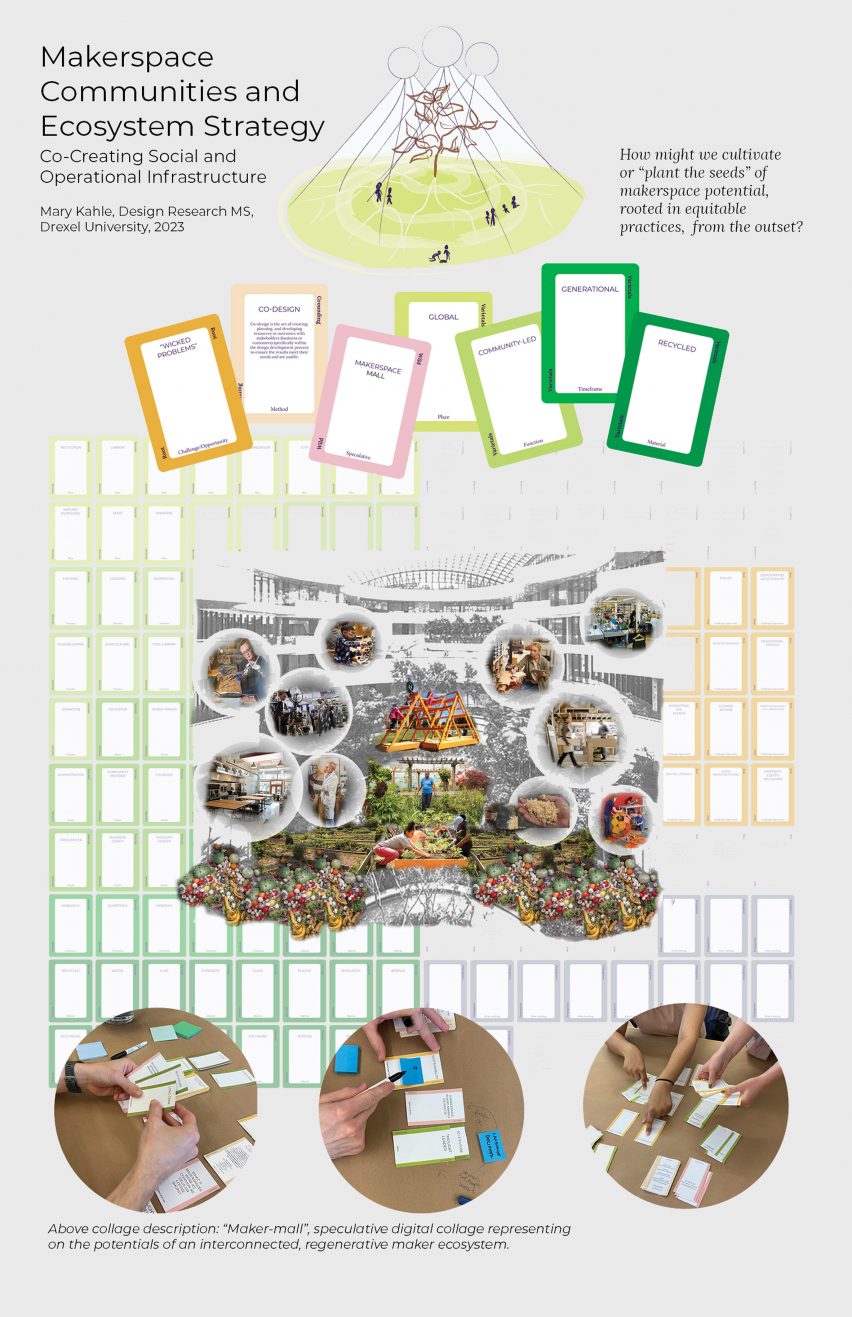
Makerspace Communities and Ecosystem Strategy: Co-Creating Social and Operational Infrastructure by Mary Kahle
"Makerspaces hold the potential to support entrepreneurship, small-scale manufacturing, access to STEAM (science, technology, engineering, arts and math) education and community engagement.
"However, makerspaces face many challenges including scalability, sustained funding, trained staff, diversity, inclusivity and accessibility. There are interconnected systemic issues preventing the ideal-state to emerge across scales.
"Kahle's study included interviews, in vivo coding, naturalistic and participatory observational studies and analysis through collaging to synthesise the research into insights for a final prototyped ideation card deck.
"The speculative digital collage depicted here is titled Maker-mall, representing the potentials of an interconnected, regenerative maker ecosystem, where makers and consumers collaboratively approach circular consumption and production.
"A participatory workshop was designed to aid in the co-development of the ideation card deck, which includes 160 cards and 10 categories.The deck acts as a versatile tool and can be brought into a framework or method to shape to the makerspace community's particular goals.
"The outcome provides grass-roots maker communities and small-scale makerspaces with facilitation tools to co-develop equitable, sustainable and accessible programmatic and organisational outcomes."
Student: Mary Kahle
Course: MS Design Research
Tutors: Nicole Koltick and Diana Nicholas

The Zipper: Capping the Vine Street Expressway by Ash Abedin
"Every American city has a network of highways cutting through their core. As we adapt to post-Covid, remote working lifestyles and become less reliant on cars, we have an opportunity to reconnect the neighbourhoods once severed by highways to beautify the city with shared public amenities at their centres.
"The proposed project in Philadelphia seeks to reconnect the neighbourhoods of Chinatown, Callowhill West and Logan Square by capping the Vine Street Expressway and reorganising Vine Street with public spaces.
"The project's location presents a unique opportunity to link a series of existing public spaces in Philadelphia by providing a robust network of pedestrian and bike paths – from river to river."
Student: Ash Abedin
Course: B Architecture
Tutor: Don Jones
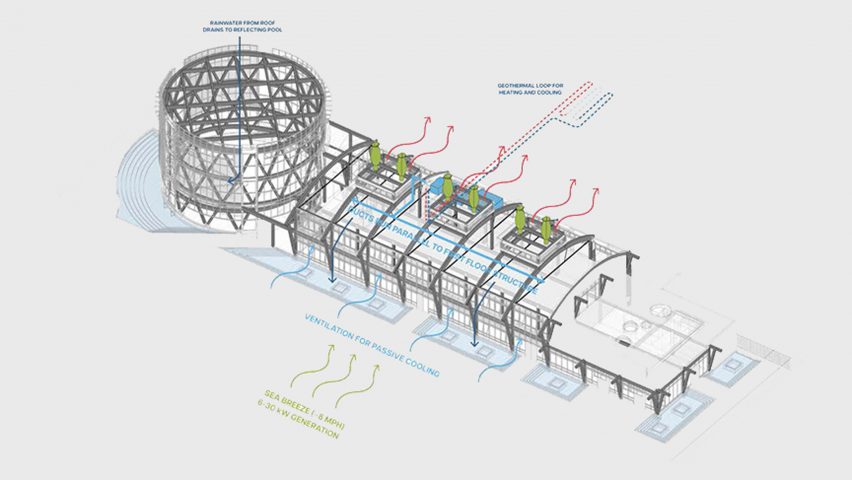
Much More than it Sounds: Designing Better Stormwater Management Facilities for the Puget Sound by Ryan Fowler
"Despite Seattle's age, a majority of the city relies on a dated combined sewage system, where both sanitary and storm sewage loads are handled by a single pipe.
"All of Seattle's drinking water – and most of its sewage treatment – is processed at the West Point Treatment Plant.
"The goal for the project was to design a new water treatment facility that not only met the current and future requirements for combined sewage treatment, but also that provided a better space, inside and out, for the neighbourhood.
"All the water, which is safely treated by the facility, will be discharged through the site to tell a narrative about the natural water cycle.
"Clean water is pumped to the top of the inner courtyard and travels down through meadows of flowers and trees. A walking path follows this stream down towards a collection pond at the northwest side of the site.
"After water fills the collection pond, it is sent into the reflecting pools along Beach Drive on the west side of the building, which change in level depending on how much water the treatment plant is processing.
"Finally, the clean water is discharged back to the Puget Sound."
Student: Ryan Fowler
Course: B Architecture
Tutor: Kelly Vresilovic
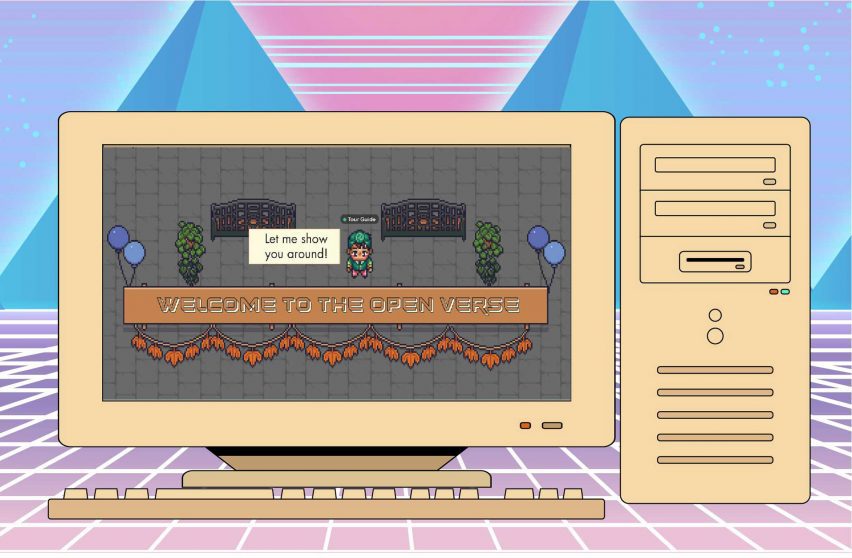
Welcome to the Open Verse: Increasing Volunteer Participation in Open Source Projects by Allison Wright
"This research looks at the systemic issues that have challenged the broader adoption of open source into the practices of the mainstream design community.
"This thesis proposed that design and open source must align themselves with the emerging field of critical design, which acknowledges that addressing some of the limitations of open source knowledge distribution must come from the collaboration of participants and researchers.
"The speculative design approach was to develop a boundary tool that could bring open source participants together in a collaborative space without standardisation or forcing participants to sacrifice tools or processes already being utilised.
"The goal was to help teams build stronger knowledge and social networks through facilitated interactions between supportive moderators and community members.
"This research trajectory led to the development of a speculative, open community design called the Open Verse. The Open Verse is a theoretical virtual space that serves as a boundary object, or cross-discipline collaboration tool, for helping to understand interactions between open source team participants."
Student: Allison Wright
Course: MS Design Research
Tutors: Nicole Koltick and Diana Nicholas

MakerHaven: A Community Arts Collaborative by Zephyr Martin
"MakerHaven is situated in Vinalhaven, Maine. Carvers Harbor in Vinalhaven is the State of Maine's most profitable fishing harbour, as well as being highly populated with artists and makers.
"Built in 1819, the Netting Factory is an existing building in Vinalhaven located directly off Main Street, that manufactured fishing nets for the island's growing industry.
"Re-use of the factory building and careful consideration of the tide and floodplain were integral to the design.
"This campus builds a creative infrastructure for the island, providing learning and making spaces for the year-round community programmes for visiting artists and makers to teach and work alongside local residents."
Student: Zephyr Martin
Course: B Architecture
Tutor: Jeff Krieger
Partnership content
This school show is a partnership between Dezeen and Drexel University. Find out more about Dezeen partnership content here.